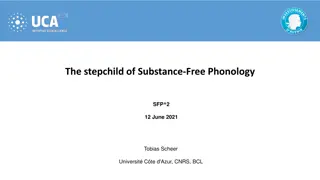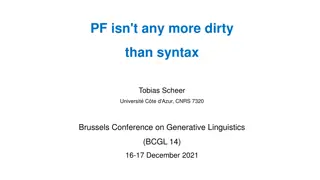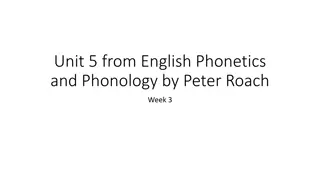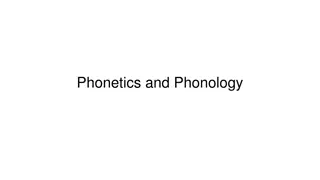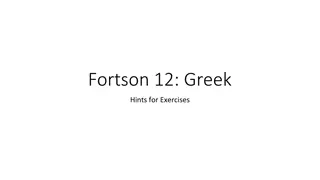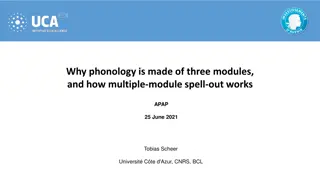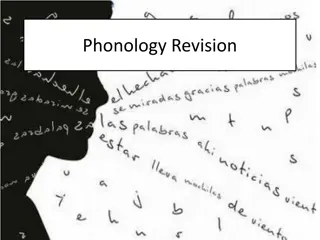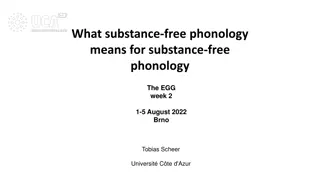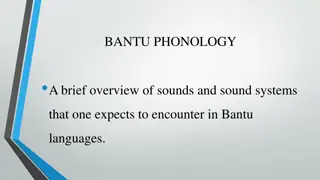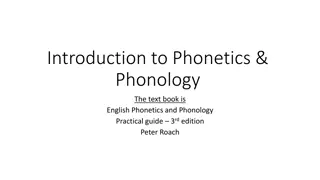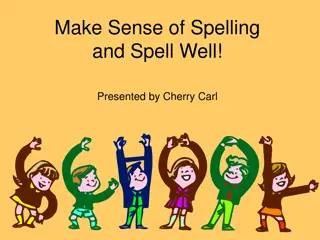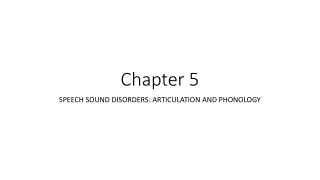Understanding Glottalisation of /t/ in English Phonology
Exploring the phonological process of glottalisation affecting the /t/ sound in English, focusing on intervocalic environments and beyond. The case study delves into word-final and word-medial positions, highlighting nuances in pronunciation and teaching points for syllable stress and articulation contexts.
Download Presentation

Please find below an Image/Link to download the presentation.
The content on the website is provided AS IS for your information and personal use only. It may not be sold, licensed, or shared on other websites without obtaining consent from the author. Download presentation by click this link. If you encounter any issues during the download, it is possible that the publisher has removed the file from their server.
E N D
Presentation Transcript
BALEAP Webinar Deak Kirkham University of Leeds
Todays issues A case study of a phonological process in English: /t/ glottalisation as in a bit of water as [ b w ] We suggest a pedagogy of this feature, exploiting it also for the relevant linguistic concepts and for critical thinking
Setting the scene: /t/ glottalisation in word final position Word glottalisation in many dialects of English internationally e.g. fat cat [f k ], not hot [n h ] final /t/ is regularly subject to However, /t/ is also glottalised word medially as in the famous Betty Botter bought some butter rhyme
Step 1: intervocalic environments Consider glottalisation of /t/ intervocalically; B does not. Why? the columns below. A allows A B Water, daughter, greater, heater, better, neater, starter, Chitty-chitty-bang-bang, hypotenuse, critic Detain, retain, pre-task, return, perturb, a tailor , co-teacher, hypertension, critique
Conclusion 1 Intervocalic /t/ not [ ] at the beginning of a stressed syllable Or: /t/ [ ] immediately after a stressed vowel in a two-syllable word Teaching points: identifying syllables; identifying stressed versus non-stressed syllables; the notion of the inter-vocalic environment; mis-match of graphic and phonic realities; the use of inductive (discovery) approach
Step 2: beyond the intervocalic environment Again, taking an inductive approach, compare sets A and B below. A again allows /t/ glottalisation; B not. Why? A B Wanted, dinted, fainted, talented panter, Tam O Shanter, ranter painting, renting, denting Destructive, deductive Laughter, craftier, crofter Waster, tastier, requested
Conclusion 2 When preceded by a nasal, /t/ [ ] as per normal, but not when preceded by a fricative or stop Teaching points: nasals / fricatives as manners of articulation; a nuance to the context; further practice in inductive thinking; re- inforcement of graphic-phonic mismatch
Some controlled practice Photograph, photographic, photographer Systemic, systematic, systematicity Potato, retorted Hospital, hospitality Pontifex, pontificate, pontifical, Critic, criticality, critique Glottal, glottalic, glottalisation Positive, positivity
Recap and revision No /t/ in the onset [= at the beginning] of a stressed syllable can undergo glottalisation Any /t/ which meets the above requirements will not glottalise if preceded by a stop or fricative Teaching points: two rules cover all the examples (in pronunciation has rules and the rules are abstract like grammar this presentation!);
More open practice Which of the written t-s can be pronounced [t]. Which of these can be glottalised? Practice the sentences slowly. I ve got to get a little bit of water in my bottle Three unrelated patients requested critical care treatment in the city hospital The destructive photographer has eaten a potato off the table in the retreat centre
ELF considerations The phonology of glottalisation mirrors to a large extent the phonology of t-flapping in some US dialects In certain contexts homophony i.e. winter and winner as [ w ]; atomic and adamic as [ m k] In Liverpudlian English, /t/ [s] in similar environments this can lead to
Broader questions Does this need to be taught (even at all?) or will students just pick it up as they go along? Is this simply awareness raising or does should students be aiming to produce [ ] in the appropriate places? Should linguistic terminology be used or avoided in teaching such processes? At what level / for what kinds of class might this be taught? What other phonological processes could be treated in this manner? Why such emphasis on grammar but so little on pronunciation grammar in EAP teaching? Should teacher training / development look at such issues? What role for linguistics in language learning / teaching?
Additional comments Positivity and hospitality seem OK to some speakers. Is this to do with ooOoo stress pattern? We don t discuss the related fricativisation of /t/ [s] across word boundaries in Liverpudlian / Irish i.e. got to get a bit of water



